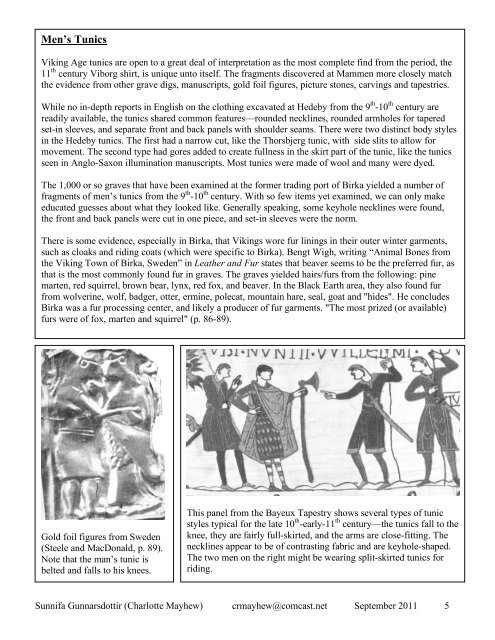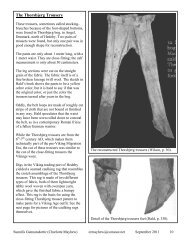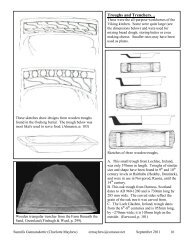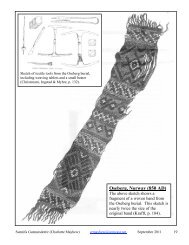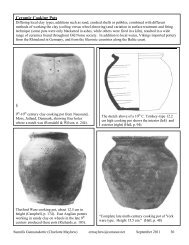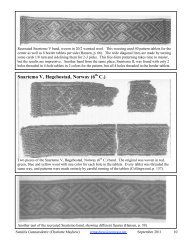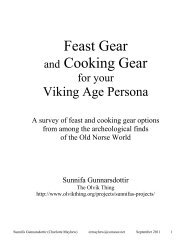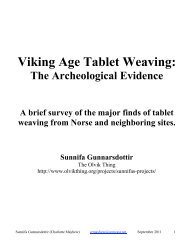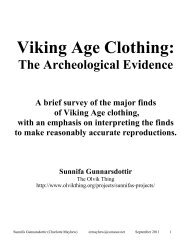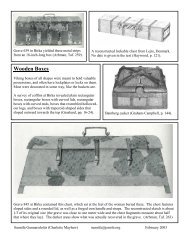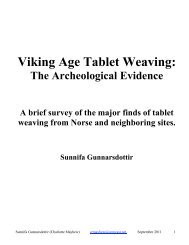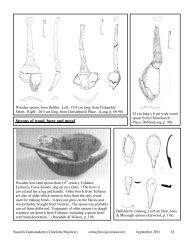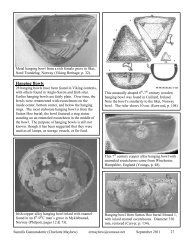Viking Age Clothing Class Handout pgs 5-9 Men's Tunics - Olvik Thing
Viking Age Clothing Class Handout pgs 5-9 Men's Tunics - Olvik Thing
Viking Age Clothing Class Handout pgs 5-9 Men's Tunics - Olvik Thing
- No tags were found...
Create successful ePaper yourself
Turn your PDF publications into a flip-book with our unique Google optimized e-Paper software.
The Mammen Costume ReconstructionKing CnutThe Mammen chieftain’s grave dates from 970-971AD. The reconstruction of the Mammen grave findclothing by the Danish National Museum(Margeson, p. 29) was derived from the Thorsbjergand Bocksten bog finds (for pattern details) andbased on the illustration to the right. Not enough ofthe tunic itself remained to make accurate guesses asto its cutting pattern. Note the square decoratedneckline that the reconstruction shares with theillustration, as well as the closely-fitting wrists. Thereconstruction is somewhat shorter, and the skirt isless full. The embroideries on the cloak and the tunicare from the Mammen bog find, as are the paddedsilk bracelets with tablet-woven trim.King Cnut, from the New Minster Liber Vitae, 11 thcentury (Backhouse et. al, pp. 77-78). King Cnutwears a knee-length tunic pouched over the belt,which is not seen (no dangling end). The tunic hasextra long sleeves that fit closely at the wrists.Also note the trim at the wrists; whether this is adepiction of separate bracelets or decoration on thecuffs of the tunic is not clear. The neckline is asquared keyhole and appears to be of a contrastingfabric, like the bottom hem. The skirt of the tunicis full and, though belted, hangs to the knee. Thecloak ties are similar in shape to the nålbindingfound in the Mammen grave, though that mighthave been a hlad or fillet worn around the head.Sunnifa Gunnarsdottir (Charlotte Mayhew) crmayhew@comcast.net September 2011 6
The Thorsbjerg TunicA sketch of the reconstructed Migration Era tunicfound in the Thorsbjerg Bog, Denmark (Hald, pp.339-340). This tunic, dated to the 6 th -7 th century, ismade of wool, though the set-in sleeves of brokenlozenge twill are a different cloth than the body ofthe tunic. The tunic is made of only 4 pieces—2rectangles for the front and back (the back one isslightly longer) and 2 rectangles for the sleeves.The sleeves are taken in below the elbow so theyare close-fitting at the wrists. The last few inchesof the sleeve seams were left open. The side seamsare also left open in the portion below the hip, forease of movement. The tunic laces up the sides.Decorative tablet-woven bands adorn the wrists.The neck opening is formed by leaving a portionof the top shoulder seam unsewn.The 5 th century Migration Era find in Evebø,Norway, yielded the remains of 2 tunics. The redwool undertunic reached to the knees. Like theThorsbjerg tunic, it had decorated wristbands. Thetablet-woven bands of the Evebø tunic werefurther embellished with bronze wrist clasps; therewas tablet-weaving at the neck and also at thehem. The wool overtunic also had tablet-weavingadorning its neck, though little else remains of it.Detail of a 12 th century manuscript depicting<strong>Viking</strong> raiders walking down the oars of theirships to attack (Owen, p. 1). Note that the tunics asdrawn are nearly knee-length and full-skirted; thesleeves are long and fit closely at the wrist.A tunic found in Bernuthsfeld Mose, Denmark,has a chest measurement of only 60 cm. Thestraight-seamed sleeves, spanning 175cm wrist towrist, need the length to bend at the elbow.Sunnifa Gunnarsdottir (Charlotte Mayhew) crmayhew@comcast.net September 2011 7
ViborgShirtThis linoleum cut by Thomas G. Andersson showsthe Viborg short as it would have been worn by itsDanish owner in the 11 th century (Fentz, p. 8).As you can see from the cutting pattern (Fentz, p.12), the Viborg shirt is a fairly complicated pieceof clothing. The upper half is lined as well asquilted, though the backs and fronts are one piece.The sleeves are pieced and tapered at the wrists.The neckline has a drawstring tie to pull it snug.Sunnifa Gunnarsdottir (Charlotte Mayhew) crmayhew@comcast.net September 2011 8
The tunic originally called the Ronbjerg Bog tunic(Hald, p. 342). Note the full cut and multiplegores. Østergård’s 2004 book identifies thisfragmentary tunic as a late 1200s textile find fromHerjolfsnes that was mis-labelled (p. 184).Three 12 th -13 th Century Tunic PatternsThe 12 th century kirtle (or shirt) from KragelundBog, Denmark (pattern by Hald, p. 342). Note thefront and back are made from one piece, while thetunic has multiple gores and tapered, pieced arms.The unusual slit neck resembles a poncho neck.This kirtle is only 65cm wide across the shoulders.The 12 th century man’s kirtle from Moselund Bog,Denmark (Hald, p. 341). The Moselund tunic wasmade of a fulled woolen 2/1 twill fabric. It was avery long and full tunic with a riding slit cut intothe front and back gores. The multiple piecing andthinner fabric pieces indicate the use of ahorizontal loom, which gradually supplanted thewarp-weighted loom in Scandinavia from the 11 thcentury onward. The Moselund tunic bears someresemblance to the Herjolfsnes, Greenland tunics,which date to the 2 nd half of the 14 th century.Those tunics also have shaped arms and slopedshoulders.Sunnifa Gunnarsdottir (Charlotte Mayhew) crmayhew@comcast.net September 2011 9


